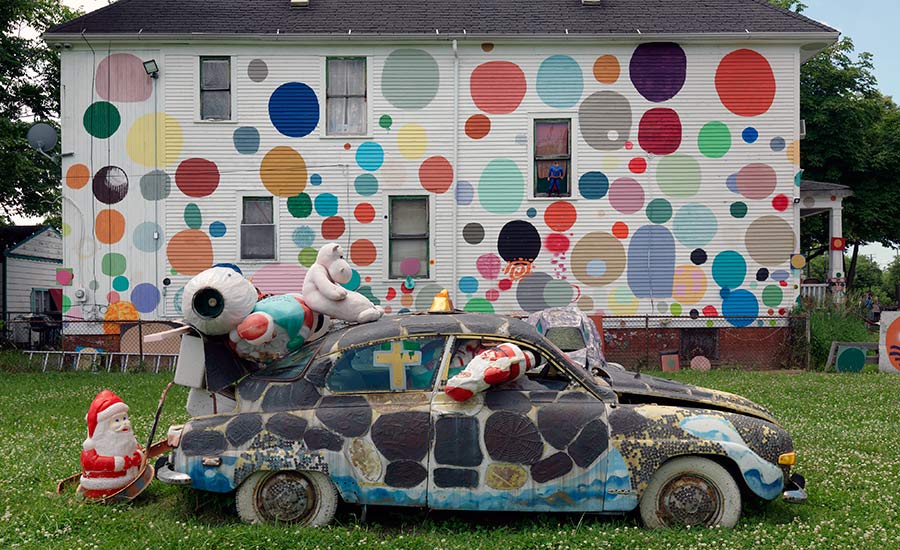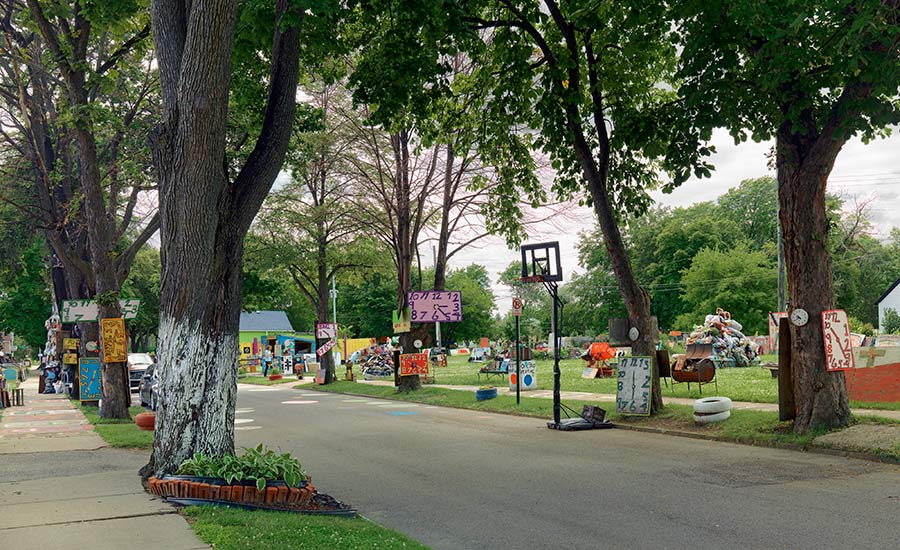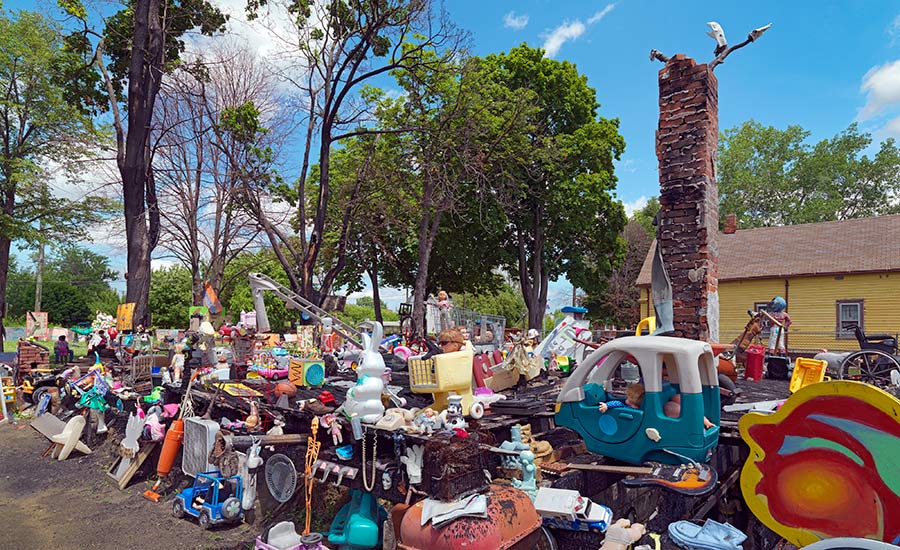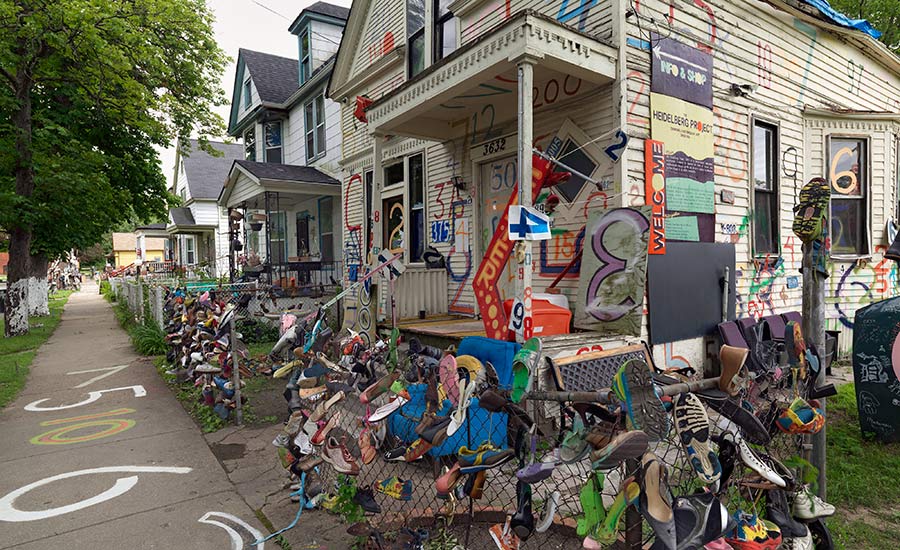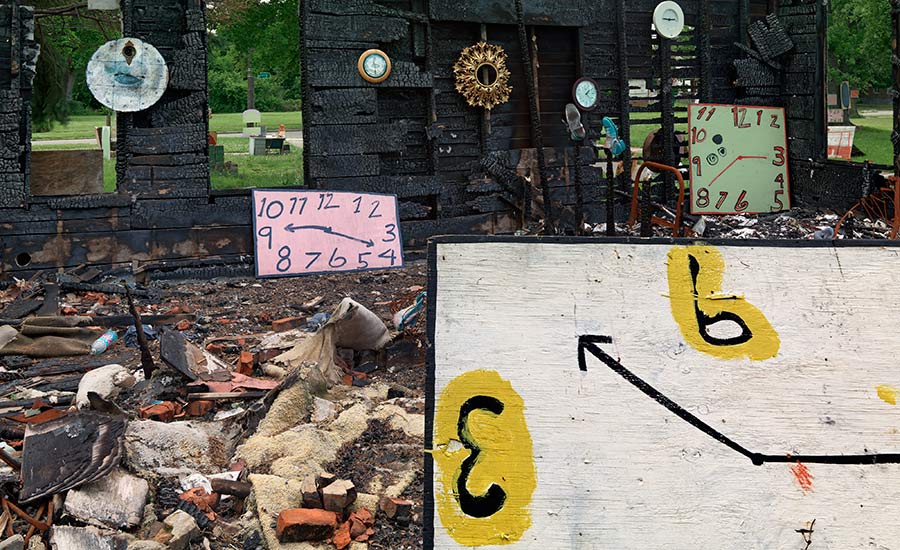“I strive to be a part of the solution. I see and understand how order is needed in the world and in our individual lives. My experiences have granted me knowledge of how to create art and how to see beauty in everything that exists. ”
History
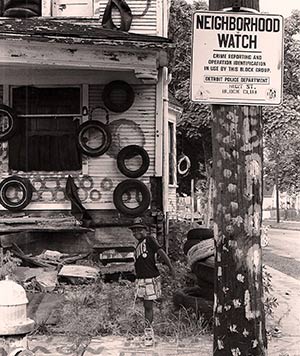
Your World House; created from 1988-91, destroyed by the
city of Detroit in 1991, photo courtesy the Heidelberg
Project archives
The story of Detroit’s Heidelberg Project is part of a tradition of artists transforming portions of blighted neighborhoods through site-specific art. The Project, which is the work of artist and Detroit native Tyree Guyton, stands out as a powerful success story reminiscent of similar artist-driven projects, such as Houston’s Project Row Houses, the Tacoma Murals Project, and the temporary site-specific installation Artists in Storefronts in Minneapolis.
Guyton started the Project in 1986 in the Heidelberg Street Neighborhood where he grew up. After moving away from the neighborhood, which included a year in Oklahoma, he returned to his old community and found that the area, which had been hit hard during the 1967 Detroit Riot, was mired in drugs and poverty. His response was to transform and repurpose vacant houses and lots along a two-block stretch into a neighborhood of thematic sites meant to educate and inspire area residents to take action. “The community was like the walking dead. Folks accepted drugs, crime and poverty as a way of life. The people had become discarded. I had no money but I wanted to do something to make a difference. I began to see new life in the discards. This became a metaphor for awakening the community,” says Guyton.
In creating his project, Guyton assembled discarded everyday objects and affixed them to houses, cars, and trees, creating themed installations out of shoes, clocks, bicycles and various other items. He painted colorful shapes, numbers, and letters on sidewalks, streets and other surfaces. In his own words: “I have come to the realization of knowing and understanding the fact that I have been called to create art that is unusual and compositional in form… My work is a science that deals with colors, shapes, objects that bring about a rare beauty to the mind and eyes of people, a type of esthete. My art is life, life that lives on with time because the entire creation is an art form.”[1] Guyton’s intent was to call attention to the transformation of the neighborhood and by doing so prompt people to examine their surroundings and imagine ways to improve them. His improvisational artwork became a way of life, as he slowly won over residents of the neighborhood, visitors and community members with his art.
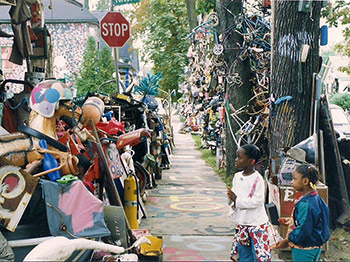
Children on Heidelberg Street, 1997, photo courtesy the Heidelberg
Project archives
Each of the houses that Guyton transformed on Heidelberg Street had a theme, including the New White House; Number House; Obstruction of Justice House; House of Soul; War House; The Baby Doll House; and Fun House among others. For example, The House of Soul was covered in old vinyl records and paid homage to music history; and The Party Animal House was covered with abandoned stuffed animals relaying the message “stop partying and get down to business.”
Today only two houses at the core of the site remain: The People’s House (Dotty Wotty) and the Number House; along with two peripheral installations, the Taxi House and the Birthday Cake House. In 1991, The Baby Doll House; Fun House; Truck Stop; and Your World were demolished at the hands of the City, followed in 1999 by two additional houses – Happy Feet and The Canfield House – and many free-standing sculptures. In 2013 and 2014 a string of arson fires claimed six more houses: Obstruction of Justice House; House of Soul; the Penny House; War House; Clock House; and Party Animal. Even with the losses Guyton has steadfastly continued his quest utilizing art as a catalyst for positive change, and creating a vibrant community of residents, artists, and supporters to help breathe new life into a neighborhood that has virtually been forgotten.
The Heidelberg Project was incorporated in 1988 as a non-profit 501(c)(3) organization with a mission “to inspire people to appreciate and use artistic expression to enrich their lives and to improve the social and economic health of their greater community.” The Project has been recognized locally, nationally, and internationally by art enthusiasts and academic institutions. According to Bradley L. Taylor, Associate Director of the Museum Studies Program at the University of Michigan: “The effect of the [Heidelberg] site on new visitors is fascinating to behold. As a frequent escort to the Project for scholars visiting my University, I often observe looks of wonderment if not outright disorientation on the faces of my guests ... Who would have imagined that in all of the seemingly random and chaotic work on Heidelberg Street, Tyree Guyton was actually building a space for all of us.”[2]

Jenenne giving tour to Kresge Foundation - June 2010, Photo by Geronimo Patton
The impact of the Heidelberg Project has extended beyond the boundaries of the community: currently the Project draws over 275,000 tourists each year and generates approximately $3.2 million of income annually for the Detroit community. In addition the Heidelberg Project has trademarked its philosophy Heidelbergology (HP-ology): The study of artistic materials, (i.e., found objects) incorporated into the fabric and landscape of an urban community and the effects on that community.
Threat
Detroit has been the Heidelberg Project’s harshest critic. Although the City has a rich history of visionaries – local politicians, civic and business leaders have found it difficult to accept this innovative and experiential art installation. Although no longer under a direct threat of demolition by the City (notwithstanding the many serious social and economic issues now facing Detroit) the City has not sanctioned or officially recognized the Heidelberg Project.
At the time of the 2013 and 2014 arson there was no response from the City government despite significant attention from the press. The fires are currently under investigation by the Department of Justice’s Bureau of Alcohol, Tobacco and Firearms, and a fundraising campaign has enabled the Heidelberg Project to enact a comprehensive security plan that provides 24-hour monitoring capabilities. Even with the damage, the site is still very much active and the Heidelberg Project’s goal continues to be to preserve the site and its legacy for future generations.
1 Tyree Guyton, “The Art of Tyree Guyton,” TyreeGuyton.com, (accessed September 2, 2014).
2 Bradley L. Taylor, “Negotiating the Power of Art: Tyree Guyton’s Heidelberg Project and Its Communities,” Museums and Communities, Curators, Collections and Collaboration, Bloomsbury Press 2013.

